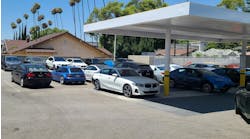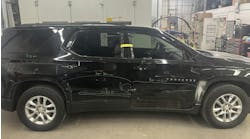Dr. Allen DeVilbiss, in 1888, and his son, Thomas, at a later date, are each credited with developing atomizing spray equipment. However, the development of the first paint spraying equipment is attributed to Joseph Binks, who created it in the basement of a Marshall Field's store to spray whitewash in 1893. But neither invention was significant until the early 1920s, when the laborious brush application of automotive finish was replaced with sprayed application. This change reduced the time to finish a vehicle from 27-30 days, to just seven. Later when nitrocellulose lacquer paints were introduced by DuPont, application time was again significantly reduced.
Though finishes have changed significantly through a long line of solvent-based, water-based, UV, and even electrostatic and powder coats, they are still applied with a spray gun about 88 years old — with no end in sight for this reliable and versatile tool.
There are many competitive spray guns on the market today, and most of them produce a fast, efficient and professional looking finish. So how does a painter decide which gun is best for him or her? Well, many choose equipment based on reasons such as "I have had the best luck with it," or "It feels good to me," or even, "My friend uses it and he is a great painter, so I bought one." Now, while how a tool "feels" or how good a recommendation it gets from a trusted friend should be considered, knowing how and why a tool works and therefore knowing its strengths and limitations, will strongly influence how much "luck" we have with it. So to size up spray guns, let's look at a few different types and usages.
Types of spray guns
Though the basic design of a spray gun has not changed much during the last 88 years, it has continued to evolve subtly and with refinements. Spray equipment has been modified to meet different production needs, the size of the object being sprayed, and even to enable the reduction of volatile organic compounds (VOCs) through better transfer efficiency. Today, spray equipment comes in many different types and applications.
Suction feed gun: This type of gun, such as the Binks No. 7, has the cup at the bottom and uses high pressure to operate it. The air that passes over the venturi stem that extends into the paint cups creates a vacuum, pulling paint up to the gun for atomization. This type of gun atomized the paint well, but because of its high pressure (50-70 PSI) produces enormous amounts of overspray and waste.
These guns have only a 25-30 percent transfer efficiency, thus wasting as much as 75 percent of the finish — is a waste both in dollar costs and in harm to the environment. Another disadvantage with a gun that has a cup below is that when painting a horizontal surface, the cup may drag in the paint if not held properly.
Gravity feed gun: Though this style also uses a venturi tube to create a suction to draw the paint from the cup to the gun's air cap, because the cup is mounted above the gun, it requires less pressure and thus produces less overspray and wasted paint. These guns may have a high enough transfer efficiency to be classified as transfer efficient compliant in some VOC-restricted areas. When gravity feed guns were first introduced, many painters complained about their not "feeling" right (feeling top-heavy), but they are now the gun of choice for most production painters.
Suction feed and gravity feed guns are among the most common found in production shops today.
Pressure feed: Though not usually seen in the collision repair shop, a pressure feed gun is often used in manufacturing applications or when large amounts of paint are required. When a bus or plane is painted, a pressure feed gun speeds up the process because large amounts of paint can be prepared and then sent to the gun through the pressurized fluid hose. A separate line feeds the gun for atomizing, with a third line supplying the pressure for the paint-holding container. The fluid cap is flush with the face because the pressure to atomize the paint is supplied through the paint tank. Pressure feed guns are remarkably efficient because they do not have the added weight of the paint attached to them. They are also easier to use, especially with odd-shaped objects, and because they are pressure feed they will spray equally well in all positions, allowing a painter to use the gun upside down.
Detail Gun: This is a smaller ver-sion of a standard size gun. They can be purchased as a siphon or gravity feed type and are used for smaller repairs or application of specialty products such as adhesion promoter or color blender, non-catalyzed products that can be left in the gun and used as needed.
HVLP vs. compliant
To help control VOCs, environmental laws were passed mandating the use of HVLP guns. These guns reduced both the amount of VOCs and material used, but because they required different techniques of adjustment, some painters found them difficult to operate. At nearly the same time as their introduction, the solids content of paint coatings changed also because of the national rule. The results: different paint techniques were required. Painters also had choices of different solvents and different hardeners. Because of these nearly simultaneous changes and because the changes came from different manufacturers, painters often didn't fully understand the adjustments that they needed to make to fully take advantage of VOC/material reduction to provide an invisible collision repair.
Often when painters apply high solids clear with fast hardeners (to increase production) using an HVLP gun, the texture is unacceptable. To combat the problem, paint gun companies developed "compliant" guns and petitioned to have them accepted in areas that restricted the use of non-HVLP. Though these guns have a transfer efficiency of 65 percent, they don't have as high a transfer efficiency as HVLP guns and thus do not save as much material as could be when an HVLP gun is used.
Painters using an HVLP gun, who choose the proper solvent and hardeners for the spraying condition and adjust their gun correctly, can produce excellent invisible repairs without needing to polish in order to reduce texture.
Understanding how they work
HVLP and compliant guns used in the collision repair industry are external mix guns. The paint and air combine to atomize paint outside the gun. While some air is used to create a vacuum to pull paint to the tip, atomization does not occur until the air from the cap and airhorns hits the paint coming out of the needle area outside the gun. For a gun to be an HVLP, the air pressure at the cap cannot exceed 10 PSI. With conventional and compliant guns, the pressure can be and often is much higher. Because of this higher pressure, the paint hits the object being painted at a higher speed and more paint bounces off, causing more overspray and a lower transfer efficiency.
Airflow
As the name implies, an HVLP gun requires more airflow or volume cubic feet per minute (CFM) of air than does a conventional gun. If the airflow is restricted at any point, at the regulator, due to the size of hose or at the quick disconnect (QD) fitting, the necessary CFM may not be available to operate an HVLP gun properly. Air hoses should have an inside diameter of 3/8-inch, with the regulator capable of supplying more volume than the gun requires. The quick disconnect fitting should be large capacity. The high volume QD fitting is absolutely necessary to supply the needed air for an HVLP gun.
Atomization
Atomization takes place outside of the gun as the air comes through the air cap and horns and hits the stream of paint coming out through the needle and seat. The higher the solids and more viscous (thicker) the paint has become, the more critical the setup is. Choice of the proper gun setup, so that it can be properly adjusted to atomize the paint, must be precise.
This can be confusing because of what seems to be a never-ending array of setup recommendations. Because a gun company does not make guns for specific paint systems, it will give a range of sizes, such as 1.2 to 1.6. A more precise recommendation is often available from the paint manufacturer, which will give specific sizes for different make and model paint guns and for each coating.
Adjustments
The gun adjustment has also become more critical than in the days of high pressure and low viscosity paints. Often in the past, especially for production painters, the gun was adjusted to full open, and the painter would compensate by painting at a higher rate of travel. If an HVLP gun is adjusted to full open, there is a higher prevalence of orange peel texture. Thicker paint is harder to break up. This is why guns are set up with smaller tips than they were before and must be adjusted to produce a fine mist atomization.
Atomization occurs in three stages:
- Stage 1: As the paint leaves the gun at the nozzle, air from the cap and horns starts to combine with the paint. At this point the paint has been broken down into large droplets but is not yet fully atomized.
- Stage 2: As the paint passes farther out from the cap, the air pressure continues to reduce the size of the paint droplets, and with the aid of the air from the air horns, it starts forming the elliptical spray pattern.
- Stage 3: As the paint travels farther from the cap (six to eight inches, depending on the gun), the paint receives the full impact from the air horn air stream, where full atomization and fan are formed. As you can imagine, distance can affect atomization immensely.
To adjust an HVLP gun for maximum atomization, the fluid adjustment cannot always be adjusted to full open, especially with more viscous coatings, as some clears are. A painter should adjust the gun to a set point such as two turns out from fully closed and then test by spraying on masking paper at the proper distance. While viewing the droplet size, the painter should adjust until the smallest droplet atomization is reached.
Air pressure adjustment
For years painters have been adjusting the air pressure at the wall regulator. If the recommendation was 45-50 PSI, they would set it at the wall, hook up the gun, and spray. Often with conventional guns this was sufficient, but with an HVLP gun, depending on how long the air hose is, this practice can starve the gun for air. If a painter adjusts a new gun to its recommended 20 PSI at the wall, with a 50-foot hose, by the time that air gets to the gun's nozzle, so much air is lost that the gun will be lucky to have 5 PSI to work with.
Though it is best to adjust a gun at the wall, the pressure should be read at the inlet, with the trigger pulled to air only while adjusting. By doing it this way, the air that normally is lost because of the air hose will be compensated for. Today, many guns come with a pressure gauge at the gun inlet to aid the operator with adjustment. If your gun does not have such a gauge, you can purchase one to help ensure you're using the proper setting. Some gauges are digital to help with the fine tuning of the gun because some recommendations are as precise as 14 PSI, and analog gauges can be difficult to read.
Fan adjustment
While fan adjustment does not affect the appearance as much as fluid does, it still should be adjusted to the proper size for the object being sprayed. Though painters want to get a vehicle panel covered as quickly as possible, if the spray pattern is wider than the object being sprayed, the paint loss becomes significant, cutting into profits.
After all the adjustments have been made, they all should be checked again because the adjustment of one will slightly affect the others. A quick final check will confirm that they are all in proper adjustment.
Though it would be nice to believe that once all the adjustments are set for each of your guns you never need to adjust them again, this is not the case. Even if you are the only person using the gun or guns, they still need to be checked before each use. Many factors affect gun adjustments, such as whether anyone other than the painter is using this air. Humidity, temperature and even wear of the gun are factors too.
It is a good practice to check the gun adjustment each time you pick up the gun to use it. This habit doesn't take a lot of time and assures the painter that all adjustments are correct.
Distance, rate of travel
As mentioned earlier, distance greatly influences the texture of the paint. It also strongly influences the transfer efficiency of the painter. If the gun is held too close, the paint will not complete the third stage of atomization. If held too far away, the properly atomized paint will become too dry (because of evaporation of solvents) during its flight from the gun to the object.
Distance is believed to be so critical to both appearance and transfer efficiency that a laser guide has been developed to aid the training of new painters. When the laser is adjusted properly, the guide will show two red dots if the gun is being held too close or too far away. At the proper distance, the dots converge in a single dot. This guide helps the new painter learn to judge proper distance and consequently to achieve optimal atomization and transfer efficiency.
Rate of travel also influences the appearance of the coating. Too fast, and the painter will have poor coverage and a light, dry appearance. Too slow a rate of travel and the paint will become heavy looking or have runs and/or sags. The painter can judge the rate of travel by observing what is called the "wet line." Though this is a skill acquired with experience and it varies from painter to painter, a good rule of thumb is that the desired rate of travel is approximately one foot per second.
Final word: a lifelong decision
A spray gun is a big investment and painters often invest in more than one gun. Your gun or guns could last your entire career. In fact, I still have my first spray gun, a Binks #7. When I started painting in 1968, the gun had been in production since 1934, and though it still can produce a fast and professional-appearing finish, it is not very efficient and does not comply with environmental laws in many parts of the country.
Choosing the correct gun for you, and knowing how to adjust that gun for its optimum operation before you invest in one — or worse yet, reinvest in another one — can be difficult. Jobbers often get guns from the manufacturer to try out, and most paint gun manufacturers have Web sites with guides to help painters learn how to adjust guns properly. Also, paint manufacturers often have either Web sites or hotlines that can be called, to assist painters as they are trying out paint guns.
First, get a gun that has the proper size needle and nozzle for the coating you will be spraying. This recommendation is best received from the paint manufacturer specifically for the paint you are spraying. Then, follow the gun manufacturer's recommendation for adjustment and distance. If you have trouble with keeping a consistent distance, try a laser guide.
If you are new to painting, you would do well to find a master painter or teacher to help you get started. Of course, there is no better teacher than experience. As the wise old saying goes, "How do you get to Carnegie Hall? Practice, practice."




